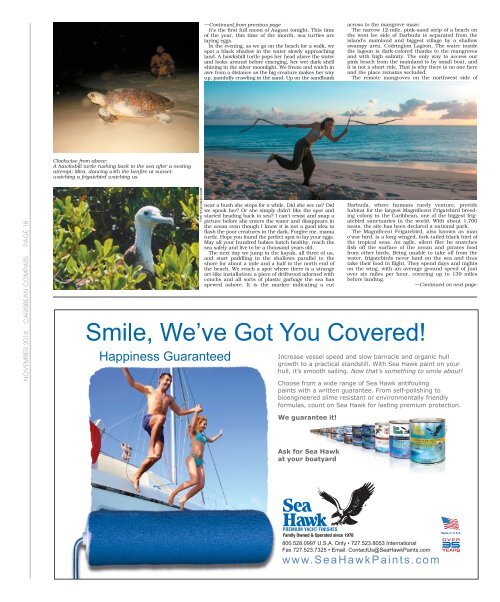Caribbean Compass Sailing Magazine
Welcome to Caribbean Compass, the most widely-read boating publication in the Caribbean! THE MOST NEWS YOU CAN USE - feature articles on cruising destinations, regattas, environment, events...
Welcome to Caribbean Compass, the most widely-read boating publication in the Caribbean! THE MOST NEWS YOU CAN USE - feature articles on cruising destinations, regattas, environment, events...
Create successful ePaper yourself
Turn your PDF publications into a flip-book with our unique Google optimized e-Paper software.
— Continued from previous page<br />
It’s the first full moon of August tonight. This time<br />
of the year, this time of the month, sea turtles are<br />
laying eggs.<br />
In the evening, as we go on the beach for a walk, we<br />
spot a black shadow in the water slowly approaching<br />
land. A hawksbill turtle pops her head above the water<br />
and looks around before emerging, her wet dark shell<br />
shining in the silver moonlight. We freeze and watch in<br />
awe from a distance as the big creature makes her way<br />
up, painfully crawling in the sand. Up on the sandbank<br />
across to the mangrove maze.<br />
The narrow 12-mile, pink-sand strip of a beach on<br />
the west lee side of Barbuda is separated from the<br />
island’s mainland and biggest village by a shallow<br />
swampy area, Codrington Lagoon. The water inside<br />
the lagoon is dark-colored thanks to the mangroves<br />
and with high salinity. The only way to access our<br />
pink beach from the mainland is by small boat, and<br />
it is not a short ride. That is why there is no one here<br />
and the place remains secluded.<br />
The remote mangroves on the northwest side of<br />
Clockwise from above:<br />
A hawksbill turtle rushing back to the sea after a nesting<br />
attempt; Mira, dancing with the bonfire at sunset;<br />
watching a frigatebird watching us<br />
NOVEMBER 2014 CARIBBEAN COMPASS PAGE 18<br />
MIRA NENCHEVA (ALL)<br />
near a bush she stops for a while. Did she see us? Did<br />
we spook her? Or she simply didn’t like the spot and<br />
started heading back to sea? I can’t resist and snap a<br />
picture before she enters the water and disappears in<br />
the ocean even though I know it is not a good idea to<br />
flash the poor creatures in the dark. Forgive me, mama<br />
turtle. Hope you found the perfect spot to lay your eggs.<br />
May all your hundred babies hatch healthy, reach the<br />
sea safely and live to be a thousand years old.<br />
The next day we jump in the kayak, all three of us,<br />
and start paddling in the shallows parallel to the<br />
shore for about a mile and a half to the north end of<br />
the beach. We reach a spot where there is a strange<br />
art-like installation: a piece of driftwood adorned with<br />
conchs and all sorts of plastic garbage the sea has<br />
spewed ashore. It is the marker indicating a cut<br />
Barbuda, where humans rarely venture, provide<br />
habitat for the largest Magnificent Frigatebird breeding<br />
colony in the <strong>Caribbean</strong>, one of the biggest frigatebird<br />
sanctuaries in the world. With about 1,700<br />
nests, the site has been declared a national park.<br />
The Magnificent Frigatebird, also known as man<br />
o’war bird, is a long-winged, fork-tailed black bird of<br />
the tropical seas. An agile, silent flier he snatches<br />
fish off the surface of the ocean and pirates food<br />
from other birds. Being unable to take off from the<br />
water, frigatebirds never land on the sea and thus<br />
take their food in flight. They spend days and nights<br />
on the wing, with an average ground speed of just<br />
over six miles per hour, covering up to 139 miles<br />
before landing.<br />
—Continued on next page


















